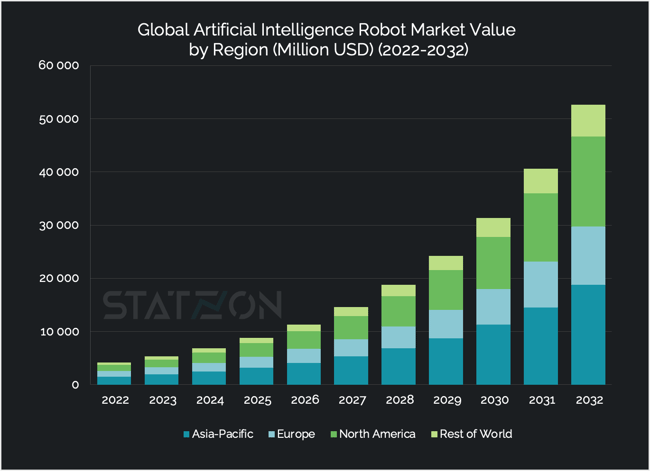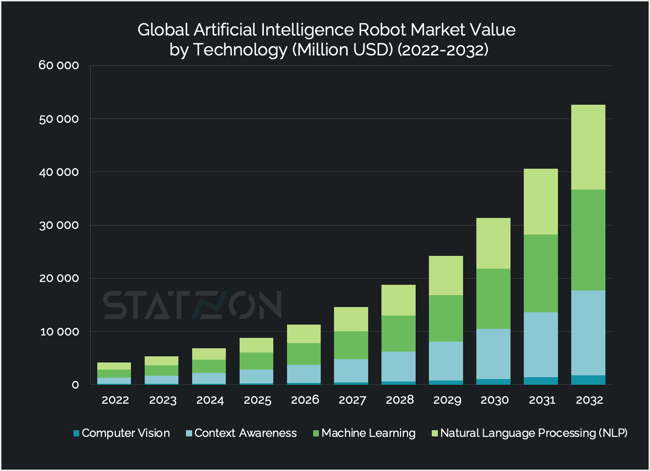Robots, once confined to industrial settings and repetitive tasks, are now venturing into sectors like healthcare and retail, mimicking human roles from caregivers to customer service representatives. This evolution is largely attributed to the integration of Artificial Intelligence (AI) in robotics. The ultimate aspiration in this AI-robotics fusion is to enable robots to emulate human-like independent thinking, a concept that remains both intriguing and contentious. As we grapple with questions about the extent of intelligence we desire in robots and the potential implications for employment, it's undeniable that the era of AI robots is upon us. Pew Research Centre, as early as 2014, predicted that by 2025, AI and robotics would permeate almost every facet of our daily lives, impacting sectors like healthcare, military, education, and logistics.
The progress of AI in robotics has been extraordinary. We have not yet realized robots with generative AI capabilities comparable to systems like GPT-4, but the merging of sophisticated AI with robotic agility is about to happen. This upcoming union is often envisioned as an "artificial mind for an artificial body."
The exploration of AI technology is vast and filled with uncharted territories of advanced capabilities waiting to be unveiled. Even in its current phase, the spectrum of AI robots ranges in intelligence, signaling a future filled with possibilities.
AI Robotics Market Size
Statzon’s database provides many data and estimations on the AI robots market. For example, the research firm Global Analysis Industry estimated the AI robots market to be around USD 9.3 billion in 2022. The market size is expected to reach USD 29.2 billion by 2027 growing at a CAGR of 25.7%. The AI robot market growth is mostly driven by the surging demands for AI robots in the industrial, automotive, retail, military, and healthcare sectors.
Another analysis from Markets and Markets estimated the AI robotics market at USD 9.6 billion in 2022 and forecast it to grow to USD 35.3 billion by 2026 with a CAGR of 38.6%. On the other hand, a more recent study from Apollo Research Reports placed the 2022 value of the AI robotics market at USD 4.1 billion. This study forecasts a 29.7% CAGR, anticipating the market size to expand to USD 52.6 billion by 2032.
Integrating AI, machine learning, and industrial robotics in industrial settings leads to higher productivity and reduced programming time. Manufacturers are moving away from standard industrial robots' rigid, inflexible capabilities. AI robots can monitor their performance and accuracy. They can also avoid downtime by indicating maintenance even before it was scheduled.
Based on a market study by Apollo Research Reports, APAC is leading in the AI robotics market with 37% of the market share or USD 1.5 billion in market value for the year 2022. North America and Europe respectively gained 27% and 24% market share. Another 11% share is attributed to the rest of the world. APAC will continue its dominance in the AI robots market until the end of the forecast period in 2032.
APAC leadership is strongly endorsed by China, the world's largest market for industrial robots. In China, the robot density in manufacturing industries reached a benchmark of 322 robots per 10,000 employees in 2021. Other countries in the regions like Japan and South Korea are also famous for their high density of industrial robots. India is an emerging market in the region that has doubled its robot density in just five years.
 Source: Statzon/ Apollo Research Reports
Source: Statzon/ Apollo Research Reports
AI Robot Market Share by Application
Major market applications of AI robots include law enforcement, military & defense, public relations, personal assistance and care, education & entertainment robots, research & space exploration, agriculture, healthcare, industrial, stock management, and others.
Military & defense has the biggest market size in the application segment, with a value of USD 1 billion in 2022. This segment will also witness the most significant growth with a 29.7% CAGR during the forecast period. The military & defense market value is expected to increase to USD 13.5 billion by 2032.
Integrating robotics and AI are utilized in the military for many purposes like facial recognition, language translation, mine detectors, scanning for intruders, and assistance in war zones, among others.
Human instruction is still needed for sensitive functions such h as releasing weapons, but AI technology coupled with advanced sensors would enable the robots to autonomously decide about selecting and engaging targets without human intervention. This is worrying scholars and policymakers as this function can dehumanize warfare and make robots more dangerous.
Law enforcement, education and entertainment, and space exploration are other areas where AI robots are commonly utilized. These segments gain a market share of 17%, 11%, and 10%, respectively.
AI robots are used for surveillance, fraud prevention, and even saving lives in the law enforcement field. Robots are trained to diffuse bombs or to find people and formulate a plan on how to save them during disasters such as hurricanes or earthquakes.
The OVObot is one example of an AI robot’s application in the educational field. This robot functions as a learning assistant for children to be used in school or at home. It guides children through subjects such as math, history, and science.
Space exploration is not new to robotics technology. The Soviet Union (USSR) launched the first robotic spacecraft in 1951. Embedding AI to robotics has led to the creation of Cimon 2, an AI-powered, empathetic robotic assistant that helps astronomers in their space travel by understanding and predicting the needs and emotions of the crew.
Cimon 2 is programmed to hear, see, speak, and understand. Its "eyes" are two cameras with facial recognition technology, and it is equipped with five other cameras that help with orientation and can be used for documentation. Nine microphones function as ears that can comprehend voices and identify directions.
Machine Learning Leading the Market in the Technology Segment
Based on technology, the AI robots market is segmented into computer vision, machine learning, context awareness, and Natural Language Processing (NLP).
 Source: Statzon/ Apollo Research Reports
Source: Statzon/ Apollo Research Reports
Machine learning dominates this segment with a 37% market share in 2022, translating to USD 1.5 billion in market value, as per the Apollo Research report. It's projected to grow substantially, boasting a 28.7% CAGR. Machine learning, a core component of AI, involves equipping systems with the capability to autonomously learn and enhance from provided data. This vast influx of information grants robots their autonomous abilities.
NLP and context awareness each holds a 29% market share, representing USD 1.2 billion in market value for both segments. By the end of the forecast period in 2032, both these segments are expected to reach a combined value of USD 16 billion.
On the other hand, computer vision is the smallest segment, accounting for only 3% of the market share, which equates to a market value of USD 121 million.
Sources: Statzon, Forbes, Pew Research, The Guardian, ABC News,
